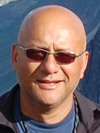 Kenneth D. Ridgway |
2012 Bromery Award for Minorities
Presented to Kenneth D. Ridgway
Citation by Sarah M. Roeske
Ken Ridgway is most deserving of this award. He is a Native American, of the Lenape (Delaware) tribe, who excels in both categories of achievement described for the Bromery award, with his significant research career as well as his active role in recruiting all minorities into science and engineering. I find it very fitting that I introduce Ken for this GSA award, because it was at GSA national and Cordilleran section meetings that I met him and had the first of many fun and thought-provoking discussions. My citation includes comments provided by his other nominators: Marilyn Suiter, Terry Pavlis, and Laura Serpa.
Many of us know Ken Ridgway, Professor at Purdue University, as an outstanding clastic sedimentologist whose research contributions are significant and wide-ranging, working on his own, and more commonly mentoring students on projects from Death Valley to Taiwan, in addition to numerous projects over much of Alaska. He thrives on field work, and leads many class field trips, often driving long distances to expose Purdue students to diverse geology. He also generously makes time to discuss research with students and colleagues from a wide range of backgrounds. One of the topics I have enjoyed seeing him pursue is what fundamentally controls basin development on a plate scale, considering everything from topographic load to mantle flow. Over the years he seeks broader connections among diverse groups, including sedimentologists, geochronologists, structural geologists, geophysicists and geodynamicists to address this and other questions. He excels at seeing the common threads in people’s research and getting people to cooperate, and his enthusiasm moves everyone forward. Thanks to my interactions with Ken, I have grown to appreciate how powerful a tool sedimentology and basin analysis can be for recording tectonic events.
The other Ken, for perhaps there are two? somehow also finds time for another career, mentoring high school and college minority students in natural sciences and engineering. He participates in professional societies such as the Society for Advancement of Chicanos and Native Americans in Science (SACNAS) and the American Indian Science and Engineering Society (AISES), and he is a recipient of and continues to support the Minority Participation Program (MPP) scholarship from the American Geological Institute (AGI). He has also become involved in a consortium of schools (San Francisco State, UT El Paso, University of New Orleans, and Purdue) that take minority high school students on a multi-week earth science field trip through the west. His most unique contribution is a program he created at Purdue in which he recruits and mentors Native American students to conduct research projects on their tribal lands, making them science experts in topics that matter to their community.
In sum, I am so pleased the Bromery Award committee recognizes his scholarly achievements and his hard work for all minorities. His mentoring supports so many students, and his creativity and enthusiasm for earth science benefit all who work with him.
 2012 Bromery Award
for the Minorities — Response by Kenneth D. Ridgway
2012 Bromery Award
for the Minorities — Response by Kenneth D. Ridgway
I am deeply honored to be the 2012 Bromery Award recipient. I very much appreciate both Sarah Roeske for her kindness in nominating and citing me for this award, and the letter writers who supported my nomination. I would also especially like to thank the Bromery family for establishing this award. I’m receiving this award in part for my outreach activities with Native American students and their communities. Working with Native students, often in the context of studying the geology of their reservations, I get to see firsthand how Western science and Native Americans’ view of the earth often dovetail.
As an example, several summers ago while teaching on a reservation, we were mapping one of the large normal faults that characterize the Colorado Plateau. This fault controls the distribution of springs across this part of the plateau. These springs in this arid landscape have traditionally been and remain the lifeline of the local Native communities. Much of their cultural identity is directly linked to the springs. The day that I’m referring to was just a perfect earth science field day; I was guiding the students on making a geologic map of the fault, we were identifying fault breccia and slickenlines, and discussing the earthquake cycle. As part of this exercise, elders of the community were also with us and discussing their perspective on the land. At one point I asked one of the elders the Native name for the high peak within this anastomosing fault zone and he tells me in their language the name of this peak translates as “Thunder in the Mountain”. The answer initially stunned me and my first coherent thought was “now here is a teaching moment for everyone”. For me the teaching moment was the striking merger of different perspectives on a landscape. Here was the Native American panoramic view of giving a name describing what I interpret as representing geologic processes in a fault zone. This teaching moment made me contrast that perspective with the classical geologic approach I was teaching the students of starting with the orientation of the fault plane, measuring slickenlines, determining stratigraphic displacement, etc., all data that then get pieced together later to form the panoramic view. Here were two very different approaches but both ended up with the same basic interpretation of earth processes.
My point in this example is that as earth scientists we have this privilege of studying an amazing planet. This privilege connects us with all of the Earth’s landscapes and with all the human communities that live in these landscapes. As you know, we have a great science and I hope that as the GSA community we continue to connect our science in meaningful and respectful ways to all people. Thank you again for this award, it means a great deal to me.
